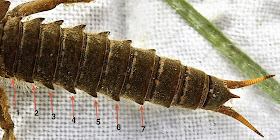This morning I went out to the Doyles where, having gotten out of my car, I expected to find nothing at all: the water was just barely flowing. We need lots of rain. Nonetheless, I decided to turn over some rocks and sort through some leaf packs. I didn't see very much, but there were quite a few little Perlids (common stones). At first I dismissed them as baby Acroneuria abnormis nymphs, a common sight in a lot of our streams at this time of year. But, they were very small, and -- I thought -- too dark for abnormis.
As soon as I looked at them through my lens, it was clear that they were Agnetina annulipes. As you know, I commonly see this species in the Rivanna in late summer and fall (see the post from 9/11), but this is the first time I've seen them at the Doyles.
There are three Agnetinas: annulipes, flavescens, and capitata, and I've found all three in central Virginia. The common name is the "Southern Stone": they're found from PA down to FL, and across the south into Alabama, Mississippi, and Louisiana. Agnetina nymphs have two features in common, two features defining the genus: they have a complete setal row at the back of the head (occiput), and they all have anal gills. They are also, according to Beaty, uncommon ("The Plecoptera of North Carolina," p. 15). That may explain why, to date, I've found flavescens only one time, and the same for capitata. A. annulipes, on the other hand, while I don't see it in a lot of our streams, I do see a lot in the Rivanna at this time of year, and without looking real long, I picked up four nymphs today at the Doyles, all of them in the leaf packs.
Here's how we tell the species apart.
I. Agnetina annulipes
This is a nymph that I found in the Rivanna last year (9/18/13), on which we can see all of the critical features: the occipital setal row, the anal gills, and in addition -- following Beaty -- the arms of the "M" pattern on the head point to the rear, tergum 10 is mostly dark, and the terga are banded with the anterior edge of each tergite being dark. Not common enough to establish a tolerance value.
II. Agnetina flavescens
This is another nymph that I found last year (11/9) in the Rivanna. It is similar to annulipes -- with some exceptions. 1) Note that tergum 10 is this case is light, and 2) the pattern on the wing pads is totally different: it somewhat resembles the symbol for batman! Not common enough to establish a tolerance value. I hope to find more of these in the Rivanna this fall: it's one of things that keeps taking me back.
I've only found one: on 5/26 of this year at the Rapidan River. As I've noted before, this species is "listed by NC Natural Heritage Program as Significantly Rare (2010)." (Beaty, p. 15) Again, a quite distinct pattern on the wing pads. And in addition, the banding on the tergites is different than we see on the other two species: here the dark bands are on the posterior edges of the terga. One more thing noted by Beaty, the "posterior margins [of the terga are] dark and with a triangular mesal area anteriorly projecting forming an apparent mid-dorsal longitudinal stripe." That stripe is easy to see on this nymph that looks to be fully mature.(Beaty, p. 15) Not common enough to establish a tolerance value.
_____________________
I sure was surprised to see annulipes at the Doyles River this morning. I love surprises!





















































